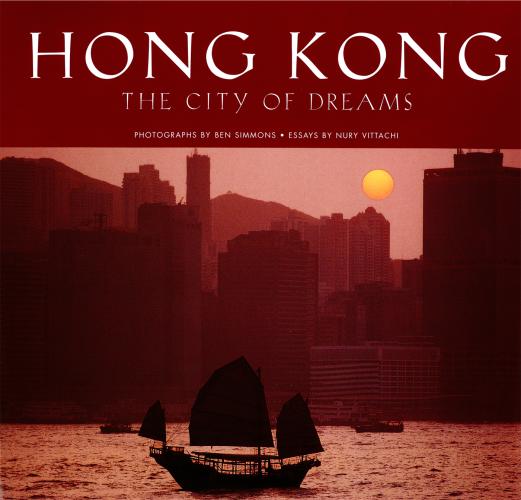HONG KONG
THE CITY OF DREAMS
Photography by Ben Simmons
Text by Nury Vittachi
Published by Periplus Editions
with editorial office at 61 Tai Seng Avenue, #02-12 Singapore 534167.
Copyright © 2006 Periplus Editions (HK) Ltd
ALL RIGHTS RESERVED. No part of this publication may be reproduced or utilised in any form or by any means, electronic or mechanical, including photocopying, recording, or by any information storage and retrieval system, without prior written permission from the publisher.
ISBN: 9781-4629-0922-3 (ebook)
Photographer’s dedication and acknowledgements
Dedicated with much love to my wonderful sisters—Sarah, Deborah, and Rebecca.
I want to sincerely thank Bob Davis, Peter Wong, Liau Chung Ren, Eric Oey, Nury Vittachi, Tim Porter, Jane Lee, Levi Christin, and Scott Marsh for their invaluable support and kindest collaboration.
Author’s dedication and acknowledgements
To Charlie, Mary, Anna and Claire.
Distributed by
North America, Latin America and Europe Tuttle Publishing
364 Innovation Drive, North Clarendon, VT 05759-9436, USA
Tel: (802) 773 8930, fax: (802) 526 6993, e-mail: [email protected] www.tuttlepublishing.com
Asia Pacific Berkeley Books Pte Ltd
61 Tai Seng Avenue, #02-12 Singapore 534167
Tel: (65) 6280 3320, fax: (65) 6280 6290, e-mail: [email protected] www.periplus.com
Japan Tuttle Publishing
Yaekari Building, 3F, 5-4-12 Osaki, Shinagawa-ku, Tokyo 141-0032
Tel: (813) 5437 6171, Fax: (813) 5437 0755, E-mail: [email protected]
10 09 08 07 06 10 9 8 7 6 5 4 3 2 1
Printed in Singapore
Hong Kong’s colourful trams have become tourist attractions in their own right. Tram rides are an excellent way to explore parts of the island and an upper-deck seat provides an excellent view of the bustling city.
CONTENTS
Sights and Symbols of Hong Kong
A CITY ON THE MOVE
“ Wherever you go, go with all your heart.”
—Confucius, 551 BC to 479 BC
Good morning, ladies and gentlemen. Welcome to the biggest transport interchange in the galaxy. Do not leave your baggage unattended. Do not stop moving. Do not bother to stop and smell the roses. (They are made of silk.)
They say Hong Kong is a city on the south coast of China, but I don’t think so. The way I see it, it’s not a city at all, but the Grand Central Station of Asia. In fact, it must be the biggest travellers’ interchange on the planet, which probably means the whole solar system, at least.
Let me explain what I mean. More people pass through Hong Kong than those that actually live here. In that sense, one can argue that it is less of a city than a huge arrivals-and-departures lounge. You want numbers? Between six and seven million people consider themselves residents. But it is not untypical in any given year for twice that number—12 million people—to actually travel in and out of the place, mostly as photo-snapping tourists and money-making businessmen.
When no one’s looking, art gradually creeps out of the galleries and onto the streets.
Business people pour in and out of Hong Kong International Airport, built on the site of a former enclave of pirates at Chek Lap Kok… so no change there.
And I submit that even the people who live here don’t belong to the place in the way that inhabitants of other places belong to their home countries. In this regard, consider the term “expatriate.” In other places, it refers to a tiny percentage of people, usually one percent or less, who were born elsewhere and who have come to that country to work. In Hong Kong, it’s not the same at all. Until the mid-1970s, more than half of our population consisted of people who were born outside the city but had come to find work. In other words, it has been literally true for most of Hong Kong’s existence that the majority of residents have been expatriates in the strictest sense of the word.
Today, the majority of members of the younger generation can declare that they were born here. But they know that their parents and grandparents first saw the light of day elsewhere. Families still like to organise visits to their heung ha, or ancestral homes, which are usually outside Hong Kong. So in historical terms, the roots attaching residents to this city do not run deep. This is not a bad thing. Indeed, I would say that it is this “new arrival” mentality, this immigrant ethic, this “now-we’ve-got-here-let’s-seize-the-day” philosophy that provides much of the restless energy that has made Hong Kong what it is.
On a daily basis, the city’s gotta keep moving compulsion is most clearly evident in the transport system, which is kept humming as it shifts millions of people a day. It seems almost everyone is always on the go. Take the underground railway: during the day, trains on the most popular lines run at frequencies of a couple of minutes or less. Within seconds of your arrival on the platform, a train will blur into the station and welcome you with open doors. Hong Kongers are so impatient that they will sprint across the platform and hurl themselves through the closing train doors at great personal risk, despite the fact that missing the train would mean that they would have a stultifyingly boring wait of maybe a whole 90 seconds!
